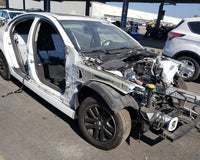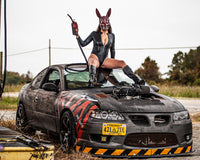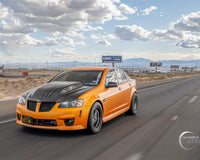Company Man
 The Rider
The Rider
Mike Smith owns this 2017 Holden Employee Reserve Edition VF Series 2 SSV Redline Ute and both the driver and the vehicle have an interesting backstory. But you won’t hear about that just yet, first the basic details. Mike is a resident of Adelaide in South Australia and has been involved in the custom scene for over 30 years and although he is an enthusiast, he is not a part of any clubs in his local area. Oh, and he worked for a number of years at the Holden Vehicle Assembly Plant in Elizabeth, South Australia which is how he was able to acquire the Employee Special Edition in the first place, but more on that soon.
He started his working life as an engine machinist where he had an unfair advantage over most enthusiasts as he could either build, cut, or modify just about any part needed for his cars. He has built a few mild customs in the past like a 1971 Datsun 510 SSS (pretty rare for the Australian Market)

with twin SU-style Hitachi carbs, another 510 this time a 1969 that was a road-registered rally car with no interior, a roll cage, racing harness, hydraulic hand brake and using his machinist skills he built a fully balanced high performance 2-liter Datsun Engine with a fully ported high compression head, oversized valves, lightened flywheel, with cylinders bored out to 0.060”, twin 45mm DCOE Weber carbs, and as he says “Just your typical old-school Datsun L-series engine upgrades.” His list of Aussie-only cars continues with a 1984 Subaru Brumby 4x4, a 1974 Holden HQ Ute that had a Holden 308ci V8 stroked to 355ci swapped in, with a front end and dash grafted from a 1976 Holden HJ, a 1983 Holden VH Commodore sedan with a new Holden 202ci straight-six, bored out to 0.060” with a mild head and cam, a “boring” 1986 Ford XF Falcon Ute that he used for carting construction materials

a 1999 Holden VT Series II Commodore Sedan with a 3.8L Ecotec V6, a 1996 Holden VS Series II Commodore Ute with a 3.8L Ecotec V6 that he still has and plans to restore, a 1974 Chevrolet Camaro LT converted to right hand drive and a silver 2001 Holden VX Series II Commodore SS sedan with a 5.7 Litre LS1 and 4speed auto and due to him working at the Holden V.A.P, he had access to a bunch of other GM and Holden SUVs and small cars. So there was no need to keep buying daily drivers over the years and he could focus on building cool cars; we all should be so lucky!
Mike reports that Reserve Editions are still relatively unknown Down Under and being a fan of the Holden Zeta platform, he decided to pick one up. And although the relative low production numbers of the Reserve Edition will likely drive up the value later on, that is not why he bought it. After spending 20 years deep in the factory he knew the vehicle would serve as a special and unique reminder of his time at the assembly plant involved in the manufacture of all those awesome Holdens. He was doubly lucky to be able to follow the assembly of his ’17 from beginning to end. And he has pictures to prove it!
The Ride

This 2017 Holden Employee Reserve Edition VF Series 2 Redline Ute is no normal Ute, as the full title implies. But it goes even a step further than that. The drivetrain, powertrain, suspension, and most of the other places that normally get customized, were left stock. But that does not mean that this vehicle is not a one-of-a-kind custom with a rich backstory, far from it. To start with, the “Employee Reserve Edition” portion of that long title means that these vehicles were exclusive to the workers of the automotive maker and ensured that the purchase was a unique reward for many years of hard work.


To have the experience of watching it being built is utterly unique. As a matter of fact, Mike’s Ute came to life at exactly 7:40am on Friday the 16th, June 2017 and he was there to see it roll off the line. How cool is that?!?!
What makes it a Reserve Edition are 19-inch alloy wheels (as fitted to the US Chevy SS versions) that were never available on any Holden vehicles sold in Australia, with red Holden centre caps (it’s Australia, and they spell it “centre” there, so deal with it grammar nazis). Holden wanted to differentiate the Reserve Edition so the word “Reserve” is embroidered on the passenger side instrument panel trim above the glovebox door in lieu of the standard model wording of SV6 or SSV etc, Reserve Edition badges are fitted to either side of the vehicles exterior and the end gate, as well as an additional chassis plate in the engine bay displaying the General Motors employee number of the staff member who purchased the vehicle and the build option code of GMH (General Motors Holden), a framed factory production broadcast sheet was given to the purchaser, and a special key fob was presented in a box with Reserve Edition badging. Mike’s employee number was also stamped into the driver’s side floor panel and can be seen from the interior.
As an employee of the factory where Mike’s beloved car was built, his ’17 was the last of only five Reserve Edition Utes to be manufactured by Holden and he had the privilege of watching it go from just sheets of stamped metal in the Press Shop, to a body shell as it progressed through the Body Shop, then the bare metal body being transformed by the Paint Shop, and finally to having its interior, power plant, suspension, and badging fitted as it became a fully functioning Ute in the General Assembly Shop. But the exclusivity does not stop there, Mike’s Ute spent four months in the main entrance foyer of the assembly plant as a shining example of what that factory was capable. It also gave him time to build a proper garage as it was kept safe at the factory.
Holden had a rich history in Australia and the name had been around since 1856 when it was a simple saddlery founded by James Alexander Holden. It operated in the leather industry until 1908 when they switched gears to produce various motor bodies including at one point the Ford Model T, and finally became a full-time subsidiary of General Motors in 1931. The company itself went through several name changes and production schedules as it produced cars under its own name and offered badge-engineered models from Chevrolet, Isuzu, Nissan, Opel, Suzuki, Toyota, and Vauxhall. Holden had several models to offer the public, but really struck a chord with the Australian market when they produced the Utility model that was not only suited to the unique terrain and needs of both the city and rural areas, but it was also unique to the Australian market.
The Ute offered farmers a vehicle to use around the homestead and bring produce to market, it offered tradesmen a stout and reliable vehicle to ply their trades, and it offered the city dweller a crossover-type vehicle that could be used to haul everyday items, motorcycles, plants, or anything they wanted while still having a vehicle that could fit into any parking space or household garage. The Ute was the symbol of the tough yet refined spirit of all Australians for upwards of 60 years before it ceased vehicle and engine production by the end of 2017. Mike’s tenure at Holden also ended, as the Elizabeth factory closed its doors that very same year. Another sad note in Holden’s rich history, on February 17, 2020, GM announced that the Holden brand would be retired by 2021.
After working as an engine machinist for six years but with a lifelong ambition to work for Holden, Mike decided on a career change in his early twenties and studied fulltime at The University of South Australia to obtain his degree in Mechanical Engineering. This culminated in his final year thesis entitled ‘Optimisation of Racecar Performance Using Data Acquisition’ (Optimise is the correct spelling in Australia, look it up)

which he wrote while volunteering for a local Holden V8 Supercar Racing team.
Some years later after commencing with Holden, Mike would also earn a Masters of Engineering through GM and the University of Michigan. Upon starting his career with Holden in 2001 he first worked as a Manufacturing Engineer for the Engine Subassembly line in the General Assembly Shop, then in various roles relating to New Model Launch, Quality, Production Management, and made the transition to GM after the Elizabeth plant closed albeit in a different capacity supporting various assembly plants outside of Australia, now that Holden no longer manufactures vehicles in Australia.

At the risk of sounding like a rambling idiot, the good folks at Maverick Man Carbon, and the humble writer you are now reading, were fans of the Holden brand, are fans of the custom car scene in general, and were deeply saddened when Holden announced the news. We still believe in the car scene, love the people in it, support the OEM manufacturers and the vast aftermarket, as well as any kid with a passion to one day grow up and customize a vehicle of their own. That is why we do what we do, that is why Mike did what he did, and we all are in this great big wonderful scene together. We just hope that you, dear reader, have enjoyed what is displayed here, because it is a moment in time, and a recording of automotive history.
To bring things back to the positive, please enjoy a selection of photos taken by Mike himself as his own 2017 Holden Employee Reserve Edition VF Series 2 Redline Ute was being built before his very eyes. Not many of us can have that experience. And we are now sharing that with you. Enjoy.
Body Shop
Mike was able to see the body panels and chassis getting welded together in the Body Shop to form the first stages of what would be his prized possession, the body shell.



This is also where his employee number was stamped into the floor panel. It is so cool to see things in their beginning stage and how the objects that mean so much to us get constructed.
Paint Shop
With the structure fully welded and bolted together Mike’s Ute traveled down the line to the Paint Shop. The robotic arms performed their well-choreographed dance as they coated the bare metal in Phantom Black and sealed it with clear coat.




General Assembly
The 6.2L LS3 with 304KW (407hp), and a Tremec TR-6060 6-speed trans were assembled together on an offline fixture before being transferred to the Engine Subassembly Line to complete the engine dress process,

before being prepped to be married to the last of only five Reserve Edition Utes to be built in Elizabeth. We can’t stress enough how cool that fact actually is.


The IP is loaded into the vehicle on Trim Line

The painted body enters the Trim line where it received its electrical wiring, interior trim and engine bay components

The Instrument Panel (IP) was robotically loaded into Mike’s Ute through the windshield opening at the start of Trim Line 3. The entire process including bolting the IP into place was completed in around 50 seconds! The embroidered ‘Reserve’ text is visible on the IP trim. Since Mike’s Ute was also the Employee Reserve Edition, he got his employee number stamped into the drivers footwell and into a badge on the chassis plate. A super rare experience.
With a majority of the parts bolted on, Mike’s Employee Reserve Edition was getting real close to resembling the stunner that it is today.

The front end module consisting of the front end frame, headlamps, windshield washer bottle, horns, impact bar and electrical sensors and wiring was assembled on a separate offline conveyor and then loaded to the vehicle at the start of Chassis Line 3. The front and rear bumper fascias were fitted immediately afterwards.
Beauty Shots
No words needed



If you would like to follow more of Mike and his adventure with his Ute follow him on Instagram @last.ute
Follow -> @last.ute
Author -> Anthony Soos
Photographer -> Mike Smith










